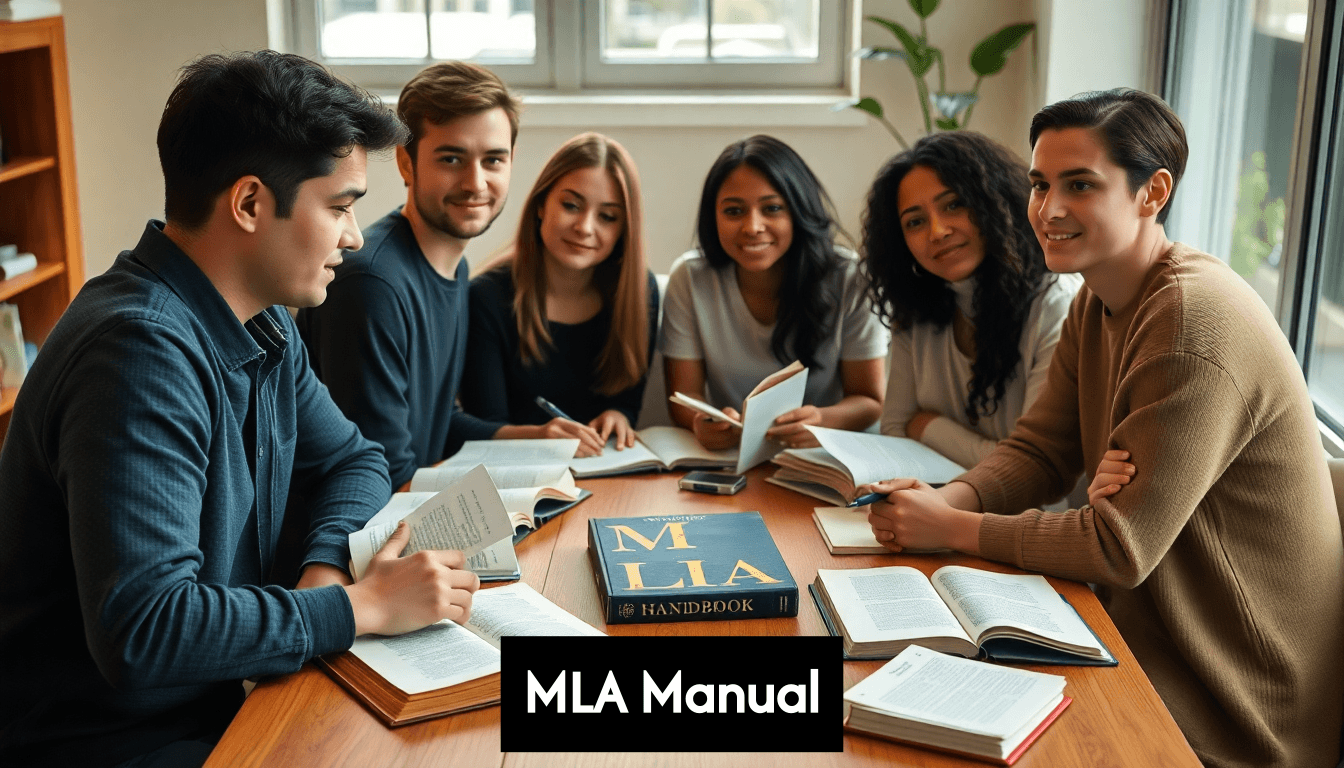Blog
Learning Materials
Your Complete MLA Manual Guide for Academic Success
Updated: April 18, 2025

Your Complete MLA Manual Guide for Academic Success

The MLA Handbook is essential for anyone delving into academic writing in the humanities. It sets out the specific guidelines that scholars and students must follow for proper documentation and citation. But here's the twist: most people think it's all about perfecting citations to avoid plagiarism. In reality, mastering the MLA format unlocks a deeper understanding of academic integrity and enhances your credibility as a writer. Get ready for a journey into the world of clear, consistent, and professional presentation that will elevate your research and writing skills.
Understanding the MLA Manual Basics
What Is the MLA Handbook?
The MLA Handbook, published by the Modern Language Association, stands as the authoritative guide for scholarly writing in the humanities. Whether you're a student working on a literature paper or a researcher preparing an academic publication, the MLA manual provides standardized guidelines for documentation, citation, and formatting. This comprehensive style guide helps writers maintain consistency while giving proper credit to sources—a fundamental aspect of academic integrity.
The handbook has evolved significantly since its first publication. The latest MLA format, found in the most recent edition, reflects the changing landscape of research and publication in the digital age. As research materials have expanded beyond traditional print sources to include websites, social media posts, and various digital media, the MLA handbook has adapted to provide guidance for citing these diverse source types.
Core Elements of MLA Style
At its foundation, the MLA manual emphasizes several key principles that govern its approach to documentation:
- Clarity and consistency in formatting throughout academic papers
- Concise documentation that provides readers with essential source information
- Adaptability to various types of sources while maintaining uniform citation principles
- Accessibility for writers at various academic levels
The MLA documentation style follows a specific pattern that becomes second nature with practice. When using the latest edition of MLA handbook, you'll find that papers typically include:
- A header with your surname and page number in the upper right corner
- A heading on the first page with your name, instructor's name, course, and date
- A centered title
- Double-spaced text with 1-inch margins
- In-text citations that direct readers to complete source information in the Works Cited list
Using the Latest MLA Edition
The Modern Language Association regularly updates its style manual to address evolving research practices. Currently, the 9th edition represents the latest MLA format, introducing refinements to previous guidelines while maintaining the core documentation principles established in the 8th edition. This consistency makes the transition between editions relatively smooth for experienced users.
The current MLA handbook emphasizes a universal set of guidelines that can be applied to any type of source. Rather than providing separate instructions for each source type, the modern approach focuses on identifying core elements present in most sources: author, title, container, contributors, version, number, publisher, publication date, and location. This systematic approach simplifies the citation process while accounting for the diverse landscape of modern research materials.
According to River Dell High School, many educational institutions maintain dedicated resources with sample MLA papers to help students visualize how these guidelines translate to finished academic work.
Why MLA Documentation Matters
Understanding the MLA manual goes beyond following formatting rules—it represents an entry point into scholarly conversation. By mastering MLA documentation, you demonstrate your commitment to academic integrity and acknowledge the collaborative nature of knowledge creation. The MLA style guide provides a common language for scholarly communication, allowing readers to easily locate and verify sources.
Familiarity with the MLA handbook serves practical purposes as well. Many professors require students to follow MLA format, making it essential for academic success. Furthermore, the skills developed through using standardized documentation—attention to detail, consistent formatting, and proper attribution—translate well to professional environments beyond academia.
Whether you're consulting the physical MLA handbook or accessing the online MLA handbook resources, the time invested in understanding these guidelines yields significant returns throughout your academic career.
Key Takeaways
| Takeaway | Explanation |
|---|---|
| Understand MLA Basics | Familiarize yourself with the fundamental principles of the MLA Handbook, including its purpose for citation, documentation, and formatting, to ensure academic integrity in your writing. |
| Follow Consistent Formatting | Adhere to MLA formatting guidelines such as using 1-inch margins, double-spacing, and proper header setup to enhance the credibility of your academic paper. |
| Master In-Text Citations | Use the correct parenthetical citation format, including the author's last name and page number, to accurately credit sources within your text and connect to your Works Cited list. |
| Create a Proper Works Cited Page | Ensure your Works Cited page is correctly formatted with hanging indents and alphabetized entries to provide readers with comprehensive source information. |
| Proofread for Compliance | Systematically review your paper for MLA compliance by checking in-text citations against your Works Cited entries and verifying formatting consistency to eliminate common errors. |
Formatting Papers with MLA Manual
Setting Up Your Document Correctly
Proper formatting establishes credibility and demonstrates your understanding of academic conventions. The MLA manual provides clear guidelines for document setup that create a professional, readable paper. When you begin formatting your document according to MLA standards, focus first on the fundamental layout elements.
Start with page setup: use 1-inch margins on all sides of your document. Select a readable, professional font—typically 12-point Times New Roman—though the latest MLA format allows for other legible fonts. Set your document to double-spacing throughout, including the header, body text, and Works Cited page. This consistent spacing improves readability and provides room for instructor comments.
According to Concordia St. Paul's Library, maintaining consistent formatting improves both the readability of your work and establishes your credibility as a writer who understands academic conventions.
Creating the MLA Header and First Page
The MLA manual distinguishes between the header (which appears on every page) and the heading (which appears only on the first page). For the header, position your last name and page number in the upper right corner of each page, including the first page. Most word processors allow you to insert this automatically so it appears consistently throughout your document.
The heading on your first page should appear in the upper left corner and contain four lines of information:
- Your full name
- Your instructor's name
- The course number or title
- The date (typically in day month year format: 15 April 2023)
After the heading, center your title. The title should use standard capitalization rules but should not be underlined, italicized, placed in quotation marks, or typed in all capital letters. The title should be descriptive of your paper's content rather than simply labeling it as "Essay 1" or "Research Paper."
Formatting the Body of Your Paper
The main text of your paper should begin immediately after your title with no extra spacing. Indent the first line of each paragraph one half-inch from the left margin using the tab key. The body text maintains the same double-spacing and font used throughout the document.
When integrating quotes into your paper, shorter quotations (fewer than four lines of prose or three lines of poetry) should be incorporated directly into your text using quotation marks. For longer quotations, the MLA handbook directs you to format them as block quotes: indent the entire quotation one inch from the left margin, maintain double-spacing, and omit quotation marks. The parenthetical citation for a block quote appears after the final punctuation mark.
Creating Section Headings in MLA Format
While not explicitly required by the MLA manual, section headings can help organize longer papers. If you choose to use headings, the MLA handbook recommends a consistent format throughout. You might use boldface for main sections and regular type for subsections, but whatever system you choose, apply it consistently throughout your paper.
Formatting the Works Cited Page
The Works Cited page is an essential component of papers formatted according to the MLA handbook. Begin this page on a new page after your conclusion. Center the title "Works Cited" (without quotation marks, underlining, or italics) at the top of the page. Maintain the same margins, font, and double-spacing used in the rest of your document.
List entries alphabetically by the author's last name. If a source has no author, alphabetize by the title (ignoring initial articles like "A," "An," or "The"). Format each entry with a hanging indent, where the first line extends to the left margin and subsequent lines are indented one-half inch.
The latest MLA format emphasizes a standard citation template that works for all source types rather than specific formats for each medium. This approach, introduced in recent editions of the MLA handbook, simplifies the citation process while maintaining the necessary information for readers to locate your sources.
Formatting according to the MLA manual may seem technical at first, but it becomes second nature with practice. The consistent application of these formatting guidelines creates a professional document that meets academic expectations and helps readers focus on your ideas rather than being distracted by inconsistent presentation.
Citing Sources Using MLA Manual
The Importance of Proper Citation
Citation forms the backbone of academic integrity. The MLA manual provides a standardized system for acknowledging the ideas, words, and works of others—a practice that distinguishes scholarly writing from plagiarism. When you properly cite sources according to the MLA handbook guidelines, you accomplish several critical objectives simultaneously.
First, citation acknowledges intellectual debt. When you reference another author's work, you're participating in an ongoing scholarly conversation and recognizing the contributions others have made to your thinking. Second, proper documentation provides a roadmap for readers who want to explore your sources further. Third, and perhaps most importantly, thorough citation using the latest MLA format builds your credibility as a researcher who engages ethically with existing scholarship.
According to SharkPapers, proper citation not only gives credit to original authors and helps avoid plagiarism but also enhances the overall quality and credibility of your research. Finding the right balance in citation practices—avoiding both undercitation and overcitation—is essential for producing high-quality academic work.
In-Text Citations in MLA Format
The MLA manual utilizes a parenthetical citation system that directly connects brief source information in your text to complete entries in your Works Cited list. This approach minimizes disruption to your writing while still providing readers with sufficient information to locate your sources.
The standard MLA in-text citation includes the author's last name and the page number without intervening punctuation: (Smith 45). This format applies whether you're directly quoting, paraphrasing, or summarizing source material. When the author's name appears in your sentence, include only the page number in parentheses: Smith argues that "direct quotation here" (45).
The latest edition of the MLA handbook provides guidance for citing sources without page numbers, such as many digital resources. In these cases, use paragraph numbers if available (Smith, par. 4) or simply include the author's name without a locator if no other numbering system exists.
For works with multiple authors, the MLA documentation style offers clear guidelines:
- Two authors: Include both last names (Smith and Jones 45)
- Three or more authors: Include the first author's last name followed by "et al." (Smith et al. 45)
- No author: Use a shortened version of the title in quotation marks or italics, depending on how it appears in your Works Cited list ("Article Title" 45) or (Book Title 45)
Creating a Works Cited List
The Works Cited page, a hallmark element of the MLA manual approach, provides complete bibliographic information for all sources cited in your paper. Following the latest MLA format guidelines, entries should be arranged alphabetically by the author's last name or, when no author is available, by the title (ignoring initial articles like "A," "An," or "The").
Modern Language Association documentation has evolved to emphasize a unified approach to citation based on core elements rather than source-specific templates. The current MLA handbook lists these core elements in the following order:
- Author.
- Title of source.
- Title of container,
- Other contributors,
- Version,
- Number,
- Publisher,
- Publication date,
- Location.
This consistent structure allows you to cite any source type by identifying these elements and presenting them in the prescribed order with the specified punctuation. For example, a basic book citation would appear as:
Smith, John. The Complete Guide to MLA Documentation. Academic Press, 2023.
While a journal article would appear as:
Jones, Sarah. "Understanding Citation Practices." Journal of Academic Writing, vol. 12, no. 2, 2023, pp. 45-67.
Handling Special Citation Scenarios
The MLA handbook addresses numerous special citation scenarios that arise in contemporary research. Digital sources, multimedia presentations, social media posts, and other non-traditional materials receive thorough treatment in the latest MLA format guidelines.
For online sources, include a URL or DOI (Digital Object Identifier) when available. The modern approach favors DOIs when possible, as they provide more stable links to electronic resources. Unlike previous editions, the current MLA manual does not require including "http://" or "https://" before URLs unless needed for clarity.
When citing sources without standard bibliographic information, such as tweets or Instagram posts, the MLA documentation style emphasizes providing as much relevant information as possible while maintaining the core element approach. For instance, a tweet citation includes the author's Twitter handle, the tweet text (truncated if necessary), the date, and the URL.
The online MLA handbook and the MLA citation tutorial resources available through many academic libraries provide additional guidance for these special cases, keeping pace with the rapidly evolving landscape of research materials.
Mastering citation according to the MLA manual takes practice, but the systematic approach of the latest edition makes the process more intuitive than ever. By consistently applying these guidelines, you demonstrate respect for intellectual property and commitment to scholarly standards.
Avoiding Common MLA Manual Errors
Understanding Error Patterns in MLA Documentation
Even with the clearest guidelines, errors in applying the MLA manual standards remain common among students and researchers. Recognizing these patterns helps you avoid the same pitfalls and present more polished, credible academic work. Many MLA citation and formatting mistakes stem from misunderstanding the underlying principles rather than simple oversight. By understanding why certain elements of the MLA handbook matter, you'll develop a more intuitive grasp of proper implementation.
Most errors fall into several categories: formatting inconsistencies, citation construction problems, and Works Cited page mistakes. Each of these areas requires specific attention to detail. The good news is that with awareness and careful proofreading, you can eliminate most common MLA format errors from your work.
According to The Daily Greenwich, maintaining readily available documentation during the writing process is crucial. Keeping your sources and citation information close at hand helps prevent errors and ensures accurate copying, minimizing creative interpretation of citations that can lead to academic integrity issues.
Document Formatting Missteps
Many students make formatting errors when setting up their papers according to the MLA manual guidelines. These mistakes are often the most visible and can create a negative first impression before your reader even engages with your content. Common formatting missteps include:
- Incorrect margins: Using default settings instead of the required 1-inch margins on all sides
- Improper header placement: Positioning the header incorrectly or forgetting to include page numbers
- Font inconsistencies: Switching between fonts throughout the document or using decorative fonts instead of standard readable options
- Erratic spacing: Mixing single and double spacing or adding extra spaces between paragraphs
- Title formatting errors: Underlining, italicizing, or placing quotation marks around the paper title
Correct these issues by establishing proper document settings before you begin writing. Most word processors allow you to save templates with your preferred settings, making it easier to start new MLA-formatted papers without repeating the setup process each time.
In-Text Citation Errors
The parenthetical citation system outlined in the MLA handbook seems straightforward but contains nuances that often lead to errors. The most frequent in-text citation mistakes include:
- Missing citations: Failing to cite paraphrased or summarized material
- Over-citation: Citing the same source repeatedly in a single paragraph without adding new information
- Punctuation errors: Placing periods before parenthetical citations instead of after
- Incorrect formatting for multiple authors: Using "and others" instead of "et al." or incorrect formatting for two authors
- Inconsistent author naming: Referring to an author by first name in text but last name in citations
To avoid these errors, familiarize yourself thoroughly with the latest MLA format guidelines for in-text citations. When in doubt, provide more information rather than less—readers benefit from clear source attribution, even if your format isn't perfect.
Works Cited Page Pitfalls
The Works Cited page represents a particular challenge because of its detailed formatting requirements. The current MLA handbook emphasizes a standard template approach, but applying this consistently requires attention to detail. Common Works Cited errors include:
- Alphabetization mistakes: Organizing entries by appearance in the paper rather than alphabetically by author's last name
- Inconsistent formatting: Failing to use hanging indents for entries that extend beyond one line
- Missing core elements: Omitting required information such as publisher or publication date
- Container confusion: Misunderstanding the concept of "containers" for sources within sources
- Punctuation errors: Using incorrect punctuation between elements or forgetting to end citations with periods
One effective strategy for avoiding Works Cited errors is to use a reliable citation management tool as a starting point, but always review and correct the generated citations according to the latest edition of the MLA handbook. No automated tool perfectly implements the nuances of MLA documentation styles.
Proofreading for MLA Compliance
Becoming proficient with the MLA manual requires developing systematic proofreading habits. Create a checklist of common errors and methodically review your paper against these criteria before submission. Pay particular attention to consistency issues that span multiple pages, such as header formatting and citation styles.
When proofreading specifically for MLA format compliance:
- Check all in-text citations against your Works Cited entries to ensure every cited source appears on your Works Cited page
- Verify that every entry on your Works Cited page is actually cited within your text
- Compare your formatting to a reliable example of MLA-formatted work
- Review all unusual citation types (websites, videos, etc.) with particular care
Thoroughly double-checking your work prevents wasted time from grading errors and demonstrates your attention to detail and commitment to academic standards. Remember that accurate citations are primarily copy-and-paste operations—there's little room for creative interpretation in MLA documentation.
By recognizing these common error patterns and taking proactive steps to avoid them, you'll produce more polished academic work that meets the expectations of instructors and publishers who require adherence to the MLA manual guidelines.
Frequently Asked Questions
What is the purpose of the MLA Handbook?
The MLA Handbook provides standardized guidelines for documentation, citation, and formatting in academic writing, particularly in the humanities. It helps maintain clarity and consistency while ensuring proper credit is given to sources.
How do I format my paper according to MLA style?
To format your paper in MLA style, use 1-inch margins, double-space your text, use a legible 12-point font (like Times New Roman), and include a header with your last name and page number. Don’t forget to properly include a Works Cited page.
What are in-text citations in MLA format?
In-text citations in MLA format include the author's last name and page number in parentheses, like this: (Smith 45). This connects your quoted or paraphrased material to the full citation on your Works Cited page.
How do I create a Works Cited page in MLA format?
To create a Works Cited page, start on a new page with the title “Works Cited” centered at the top. List all entries alphabetically by the author's last name, using hanging indents for each entry and following the core elements outlined in the MLA Handbook.
Elevate Your Academic Writing with Samwell.ai!
Are you feeling overwhelmed by the intricate details of the MLA Handbook? Whether it's proper in-text citations, creating a consistent Works Cited page, or formatting your paper just right, mastering these elements can be a daunting task for many students and academics alike. The heart of academic success lies in the commitment to clarity and integrity, just as highlighted in your complete guide to the MLA manual. But what if you could transform this arduous process into a seamless experience?

Enter Samwell.ai—your ultimate companion in academic writing! Our advanced AI platform not only automates essay writing with impeccable MLA citations but also ensures that your work is original and undetectable by AI detection tools. With features like guiding essays, citation management, and plagiarism prevention, you can confidently navigate the complexities of your writing tasks. Don't let formatting nightmares hold you back—take action now and streamline your writing experience! Visit us at https://samwell.ai and elevate your academic journey today!
Generate essays with Samwell.ai
Whether you’re a publisher, professor, journalist, or student, let us tailor a plan just for you.Most Read Articles

Your Guide to Help Writing a Essay Successfully
Expert tips for help writing a essay - from crafting a thesis to structuring your essay effectively.

How to Write Critical Thinking Essay: Expert Tips
Expert tips for writing a critical thinking essay. Learn how to structure, choose topics, and use evidence effectively.'

How to Write a Good Hook: A Step-by-Step Guide
Master the art of crafting a good hook with our guide. Create compelling openers for a memorable first impression.

